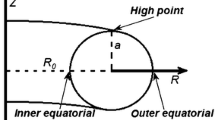Abstract.
Multifaceted asymmetric radiation from the edge (MARFE) phenomena during lower hybrid current drive (LHCD) Experiments on the HT-7 superconducting tokamak are summarized in this paper. The best correlation has been found between the total input (ohmic + LHCD) power and the product of the edge line average density and Z eff. Studies show that the critical density of MARFE onset is observed in the region of Z eff 1/2fGW = 0.6-0.9, where \(f_{GW} ={\bar {n}_e }/{n_{GW}}\), (here \(\bar {n}_e\) is the maximum line average electron density and nGW is the Greenwald density). These MARFEs generally appear to have the same characteristics as high fGW MARFEs and are positionally stable throughout the LHCD pulse. Improved confinement mode induced by a MARFE is observed, and it is maintained for about 65 ms. MARFE cools the plasma edge, and the electron density profile is observed to become more narrow and peaked.
Similar content being viewed by others
References
Y. Liu, HL-1M team, in Proceedings of the 17th International Conference on Fusion Energy, Yokohama, Japan, 1998 (IAEA-CN-69, IAEA, Vienna, 1999) EXP2/17
B.J. Ding et al., Nucl. Fusion 43, 558 (2003)
M. Asif et al., Phys. Plasmas 12, 082502 (2005)
G.L. Kuang et al., Fusion Sci. Tech. 36, 212 (1999)
Y.X. Jie et al., Int. J. Infrared Millimeter Waves 21, 1375 (2000)
B. Lipschultz, Nucl. Fusion 24, 977 (1984)
X. Gao et al., J. Nucl. Mater. 279, 330 (2000)
J.J. Martinell et al., Phys. Lett. A 326, 259 (2004)
M. Greenwald et al., Nucl. Fusion 28, 2199 (1988)
B. Lipschultz et al., Phys. Rev. Lett. 81, 1007 (1998)
W.M. Stacey, Phys. Plasmas 3, 2673 (1996)
Author information
Authors and Affiliations
Corresponding author
Rights and permissions
About this article
Cite this article
Asif, M., HT-7 team, t. Multifaceted asymmetric radiation from the edge along improved confinement mode in LHCD plasmas with graphite limiters on HT-7 tokamak. Eur. Phys. J. D 42, 269–272 (2007). https://doi.org/10.1140/epjd/e2007-00025-9
Received:
Published:
Issue Date:
DOI: https://doi.org/10.1140/epjd/e2007-00025-9



